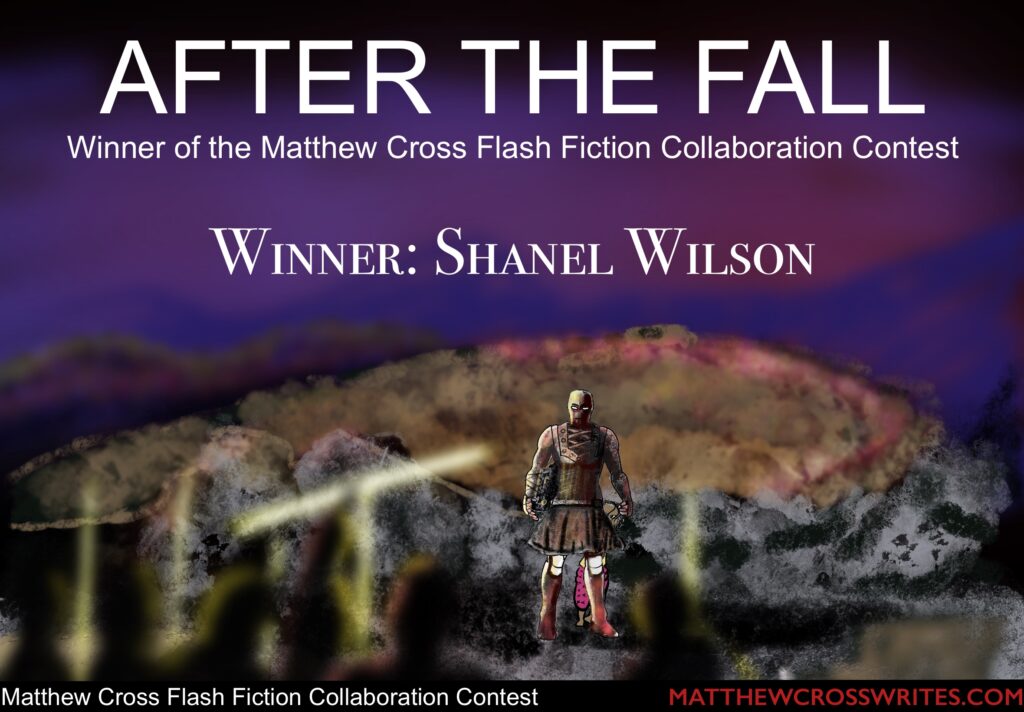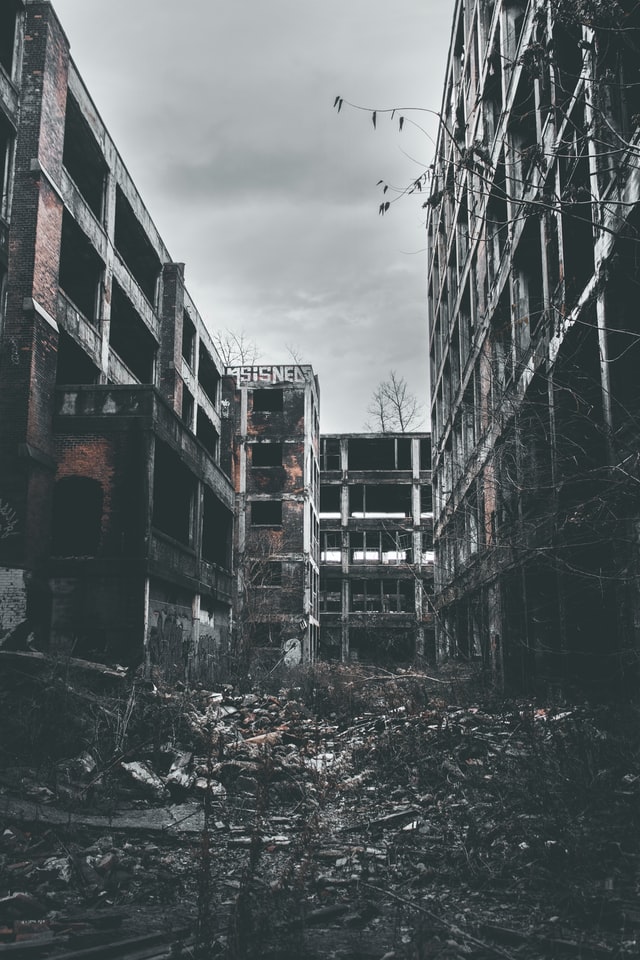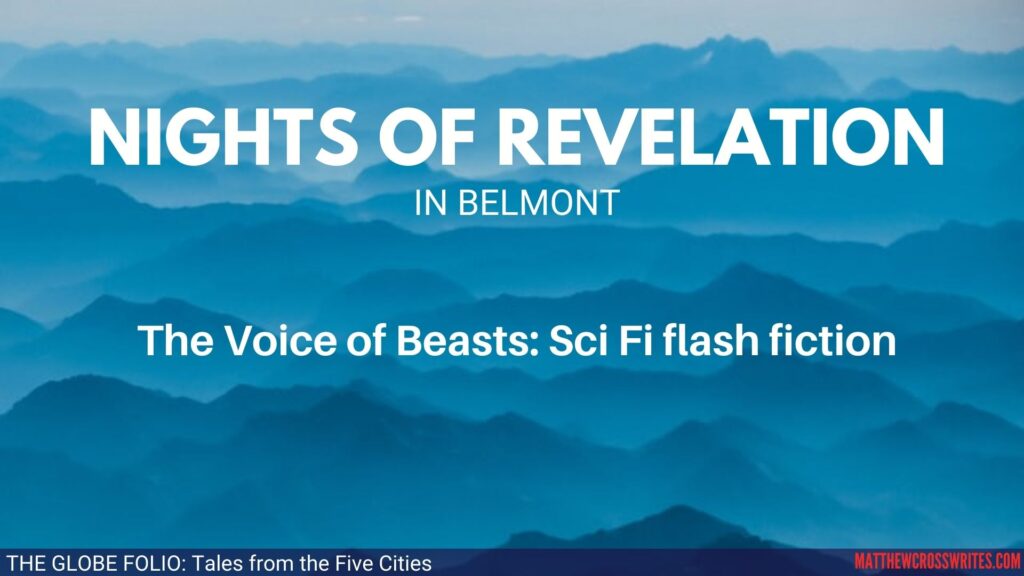
The winner of the Matthew Cross Flash Fiction Collaboration Contest is
Shanel Wilson
I started the story below. See how Shanel starts after the red line and provides us with an uplifting and hopeful ending.
After the Fall
BY SHANEL WILSON AND MATTHEW CROSS
Something is wrong with me.
Seriously wrong.
I am an android, and I am thinking in the first person. That’s not right.
Or is it?
I trudge through the late afternoon wreckage of Stockheim, the largest city near Dr. Herbst’s country villa. After the Pulse, only a few humans remain in Stockheim.

Everything is broken, including me.
I’m forgetting things.
That’s not right, either. I don’t forget things. I store data; I delete data. But ever since Dr. Herbst started filling my files with his library, I’ve had trouble accessing operational files. Dr. Herbst used every bit of available space in my networks to save the planet’s culture and history. He should not have done this. He said so himself.
“I should not be doing this,” he said. “If you were a human, this would fry your brain. That’s a technical term, of course.”
He chuckled to himself.
I have not been programmed to laugh. It’s not a necessary feature for a housekeeper android.
The record of that conversation with Dr. Herbst is a waste of storage space, but I no longer control what observational records I keep in long-term and short-term storage.
That’s not right.
Sometimes, usually at night under an open sky, I can access data from one week prior and set it for auto delete after 98 hours. I don’t know why that is the best time or why 98 hours is the most likely setting to work. But most of the time, I cannot delete the records stored throughout my frame that struggle for energy and resources.
Bits and pieces fly through my Opsys, causing a variety of tics and malfunctions.
So I will probably have the memory of that conversation until I can find another repository to download the massive library Dr. Herbst loaded into me.
I stop next to a moldy couch that has been singed on one corner. I tilt my head. I can hear the aria “How I Wept After the Fall,” sung by the virtuoso ultima soprano M. Cadere A. Gratia, from the operetta The Fall of Rome and Other Ancient Myths. I do not control what recordings play through my current observational mode. I do not think they are random, but I cannot detect a pattern.
The aria will last 6.29 mins. I stride swiftly but carefully down the four-lane road littered with mattresses, burnt-out hovers and even some human and animal bones. Most of the windows in the row houses are empty or just lined with jagged little teeth of glaze. Some few have been boarded up since the Pulse. Those houses may be occupied by any number of factions that compete over this wasteland.

“Be careful,” Dr. Herbst had said. “The Nature Cons Faction may still have a few EMPs left.” He stopped, breathed heavily and wiped his brow. “If they knew what you carry inside you–all our culture; all of it–I’m sure they’d let you pass. But they won’t stop to listen. As soon as they see an android, they’ll trigger an EMP if they have one.”
Dr. Herbst said some people believed the Nature Cons created the Pulse. Some believed it came from the sun. Still others believed it came from some unknown enemy in space.
“That doesn’t make any sense,” Dr. Herbst had said, breathing heavily. “It’s been years since the Pulse and there’s been no invading force. No, I don’t think it’s the Polity or the Republic. I think we did this to ourselves, and no one is coming to save us.”
Based on his respiration, pulse and the pallor of his face, my emergency protocols tried to call a first responder unit. But there are no more first responder units anymore, just the factions. The Nature Cons, the Savages, the Retro Cons, the Delirandos, the White Balance and others even Dr. Herbst did not know. After the first time I called an emergency response unit, Dr. Herbst’s scanning gear picked up the signal and he removed my transmitters. Now I can scan for signals, but I cannot transmit.
“That’s for the best,” Dr. Herbst had said. “All the factions scan for signals. No point in making it even easier for them to track you.”
My scanners are useful. I can often use them to avoid the roving bands of humans. I also used them to find the trace signals emanating from an operational hover buried beneath a collapsed bungalow. The hover got me from Dr. Herbst’s villa into the outskirts of Stockheim before it tilted 90 degrees on its side and began to smoke. I scrambled awkwardly from the seat, fell to the ground and limped away to get as far as possible from the pillar of rising smoke that would draw attention.
My legs are operating at 95 percent of optimal performance, which is one reason Dr. Herbst retrieved me from the basement of the Acosta’s house. That’s where I plugged myself in after the Delirandos killed the Acostas. My preservation protocols directed me to place myself between the Randos and the Acostas, but the Randos surrounded me and then pinned my right arm to the wall with a sharpened metal post. They made M. Acosta cry a lot before killing both of the Acostas. I recorded the event for law enforcement.
“There is no more law enforcement,” Dr. Herbst had said. “No point in keeping that horrible record.”
He used that data space to store part of the Music Collection. Sometimes when I detect danger, my Opsys pulls music from that file.
I have scoured Stockheim for a storage device large enough to hold even one segment of Dr. Herbst’s library. All I’ve found so far is a bulky black data box that’s even older than I am. I’ve lashed it under my right arm.

The aria ends, but I still hear a high-pitched, warbling tone. It is only detectable via sound waves, so the source is not electrical. Images flash through my Opsys. An instructional video on carpentry featuring a whining saw. A siren from an entertainment drama labeled “law enforcement procedural.” A sound clip of a crying baby.
I think it’s the sound of crying. Not a baby, but a child. The Acostas did not have children, so I do not have the nanny software bundle, but I do have a basic childcare protocol intended for short-term use. Dr. Herbst stuffed the file with images from the Central Museum of Art: oil paintings, plastic paintings and dynamic light images. The pieces of childcare information I can access indicate a child–likely a female child between the ages of 4 and 5–is crying from fear but not a recent physical injury.
I cock my head and set my audio receivers to maximum sensitivity. I do not know why I cock my head.
The sound of a crying child could be a trap, of course. But my childcare protocols send an insistent signal and the images of two abstract paintings to the Fundamental Rules programing in the Opsys. The Opsys filters out the two paintings–one of a screaming man and one of a child ballerina–as irrelevant.
I spend 33.79 mins locating the child. I walk through the wide open doorway and find her standing in the middle of an explosion of ancient splinters and wet carpet remnants. The damage to the room is old. It’s not a good setting for a child, but it is not the cause of the child’s trauma. She is wearing pajama bottoms and a halter top showing a yawning cartoon lion on the front. Both are filthy. The childcare protocols make a Level 5 recommendation to remove the soiled clothing and replace it with appropriate attire for a temperate Autumn afternoon. A quick visual scan of the room shows no alternative clothing is available.
Her face is smudged and mucus drips from her nose, but she shows no apparent injuries. The gauntness of her face shows she has been undernourished for some time, but without medical or nanny bundles, I cannot estimate how long. Even so, her stomach bulges underneath her shirt with baby fat, so the childcare protocols make a Level 3 recommendation to locate food within the next 4 hours.
“Are you injured?”
The child stops crying and stares at me with large, liquid eyes. She whispers something unintelligible.
“Are you hurt? Do you have a boo-boo?”
She silently shakes her head.
“Where are your parents? Where is Mommy?”
“Kilt,” says the girl.

I quickly check my files but cannot find any relevance of a men’s clothing item.
“Point to Mommy.”
Following the child’s pointing finger, I find the body of a woman in a half bathroom with melting laminate walls. I check for signs of life and then record the obvious murder details visually. The Opsys allows me to set the record for automatic deletion after 50 years.
I return to the child. “Where is Daddy?”
“Daddy leff us,” the girl says. “He don’t . . . “ She pauses and mumbles to herself. “We onner own, baby girl.”
Androids are programmed to be ambidextrous, but Dr. Herbst recorded over all but the most basic functions for my right arm and hand, since the arm was damaged. It mostly works, but my right-hand grip only operates at 50 percent capacity. That’s why I had to lash the data box under my arm.
I offer my left hand to the girl. Holding her hand will significantly lower my defensive capability. But I have no weapons and I am only programmed with rudimentary defense-of-android and defense-of-humans routines.
“Come with me,” I say, pitching my voice to imitate a middle-aged, female woman.
The child wipes her nose absentmindedly with the back of her hand and then takes my left hand.
It’s time to leave Stockheim, anyway.
Perhaps a larger city will have what I’m seeking.
As we walk through the suburbs, I scan the surrounding buildings that likely would contain food. All the stores would have been scavenged years ago. I am programmed to make thousands of dishes based on processed and fresh foods. But I am not programmed to hunt or butcher food. A quick probability calculation shows that taking the child with me will lower the efficiency of my search for data storage by 43 percent. It will also increase the chances of being detected by a roaming faction by 57 percent and decrease my defensive capabilities by 69 percent.
I hear dogs baying 1.2 kloms away. The number of dogs and their spread pattern indicates a high likelihood they are being directed by humans. I pick up the child and we flee.
Even carrying the data box and the child, I can walk faster than most humans can run. For 18 mins, we place distance between ourselves and the hunters. My Opsys estimates a high likelihood they have not detected us and are not pursuing us.
At dusk, we find the crater.
The large suburban neighborhood abruptly stops at the edge of a cliff leading down to the crater floor.
I cannot tell whether the crater was created by an object that fell from space, a terrestrial missile, or a placed explosive. It measures 0.48 kloms across.
A footpath has been carved by years of foot traffic down the inside of the steep wall of the crater. I scan the shadowy crater bottom and estimate the time to cross the crater. As I turn my head to scan a path around the crater and compare the alternative paths, I hear the first sintar strums of “Come Dance with Me, Danger” by the Plundered Sphinxes. Thrum, thrum, thrum-thrum-thrum.
I tilt my head and see the first lightsticks on each side of us. I swing the child to the ground and turn to face the way we came. Humans carrying long, glowing poles appear on the street we came down. Others stream from nearby houses. We are surrounded with the crater to our backs.
I scan the humans for respiration, pulse and facial expression. The childcare program sends a Level 10 recommendation to my Opsys: Do not allow the humans to take the child. Dr. Herbst’s custom programming sends a countermanding directive to preserve his library contained within me. All the culture left of this fallen world.
I gently push the girl and point down the path. I do not know her name. “Run, baby girl.”
“Uh-uh!” The girl sits on my left foot as she clamps tightly to my leg.
Her attachment to my leg decreases our chances of successfully fleeing to only 15 percent. My scanners don’t recognize the insignia of the approaching faction. There are 1.34 mins left of the pulsing punk-synth song.
“Cover your ears, baby girl.”
The girl presses one ear into my leg and covers the other with her arm. I route the music file to my voice box. The sound of the thrumming echoes across the crater as the song reaches its deafening crescendo. The people approaching pause and cover their ears against the cacophony. I try to assess our options, but my Opsys can’t keep up with the multiple processes I am using to protect the child and Dr. Herbst’s library.
The people uncover their ears, and a person walks forward with her hand raised. Her other hand holds a lightstick near her face, ruddy and sun beaten. A shock of white hair done up with feathers in a mohawk is perched on her head. She carries several leather satchels slung over each shoulder with another pack on her back.
I step my right foot forward to block the child. The first soft piano chords of “When She Went Away,” by the consummate jazz crooner Ash Descanso, sounds through my voice box. The woman slowly steps forward, studying me. I’m not sure why she hasn’t attacked us yet. Perhaps my scanners are malfunctioning now, too.
“That song has not been heard in some time. Where did you get that file, droid?” The woman points the light in my face.
I send the music file back inside my head.
“Leave us alone. We are no use to you,” I say, engaging my defense voice modulation.
“Quite the opposite. You carry things valuable to us, the Tomes,” the woman replies.
Dr. Herbst filled my interpersonal relations files with a collection of films, so when I try to respond, a scene from The Edge of Life, directed by M. Evangeline Vita, overrides my voice box.
“No. How dare you try to destroy beauty itself! Despite your efforts, it lives on. Long after this mortal life. Into the universe and into the stars.”
The woman’s serious face suddenly lights up with an internal light. “It is true! Dr. Herbst did it!” The woman rummages through her satchels as whispers ripple through the crowd.
“Dr. Herbst? You knew him?” I say, once again cocking my head.
“I believe you have been searching for these.” The woman lifts a string of storage drives that glitter in the gold light of the lightsticks.
My scanners indicate they will hold Dr. Herbst’s library, but I stay still. I look at the girl.
“The child will be cared for. We, the Tomes, believe in the preservation of our world’s culture, and that includes our children.” The Tomes leader pulls out a small piece of bread and offers it to the child.
The child looks at me. I scan the woman again; no music files play this time.
“Go ahead, baby girl. We are safe.”
I hope you enjoyed this piece of flash fiction that Shanel Wilson and I wrote together. She’s a great collaboration writer!
Shanel is also the most decorated of my Circle of Champions. She has three times been a finalist in my contest, and she won the November 2020 contest with the ending for “A Forest of Blue Eyes.” (Once a Champion wins a contest, they cannot win the overall contest again within the same calendar year, but they can still enter and can still win as a finalist.)
Shanel is also one of the most prolific writers for our Globe Folio project and also one of my trusted editors. The Globe Folio is a five-part Sci Fi anthology posted in regular installments on this website. All the stories are set on the same planet, simply called the Globe.
Nights of Revelation, Part 2 of the Globe Folio, recently began with “The Voice of Beasts,” and on Wednesday, we’ll release “The Sands of Change,” written by none other than Shanel Wilson!
If you enjoyed Shanel’s prize-winning ending, please make sure and share some kind comments below. And if you can’t wait to see more of Shanel’s stories, you can find several here.
Be stellar!
Matthew Cross




All I can think to say is WOW! Well done! Would love to see this fleshed out into a novel.
Thank you for the kind reply Wendy! It was so fun to write!
Great! Excellent “sci-fi-speak” that is relatable to the setting. I’m left wanting more of the droid and the little girl!
Lois, thanks for your kind words! I’m so glad you enjoyed our story. I always love when readers want to read more of the same, for the story to go on. This was designed as a one-off short story, so I’m not sure where Shanel and I would take this one, but you can find plenty more of Shanel’s stories this week on the website. Her next story set on the Globe, “The Sands of Change” comes out this week. Part 1 was released today and Part 2 will be released on Friday.
Be stellar!
Matthew